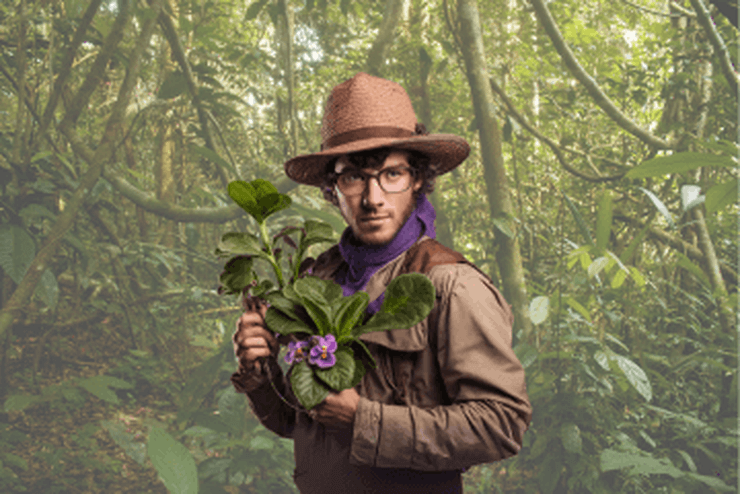I have great admiration for plant hunters, each one a botanical Indiana Jones. They sailed with Captain Cook on his first great voyage in 1768 and still today they are exploring remote corners of the world, seeking out rare plants.
Back in 1892 one casual explorer was Baron Walter von St. Paul. Walter, full name Adalbert Emil Walter Redliffe le Tonnevy Von St Paul-Illaire — I’ll stick with Walter. He was the Regional Commissioner in the northern port of Tanga in German East Africa, and a keen plant collector. He was wandering about in the Usambara mountains of northern Tanzania, home to a large population of hungry lions. He may have been hiking through the hills for exercise, or he was trying to escape the heat, but whatever he set out to do that day, Walter made a fortuitous discovery.
He hadn’t climbed very high, around a couple of hundred feet above sea level, when he spotted a small plant in a cool, rocky crevice It was shaded from the hot sun and rooted in just enough decaying vegetable to sustain it. It wasn’t much of a plant, but something about it was vaguely familiar to the baron. The hillside may have been covered in it, or it may have been the only one in sight, but I doubt Walter realized he was looking at a plant that would become one of the most popular houseplants in the world.
First, he had to dig it out and ship it home to his father in Germany who, recognising it as something unique, rushed it over to Herman Wendland, director of the Royal Botanic Gardens in Hanover. Herr Wendland studied the plant and concluded that it was indeed a new species and should be named after Walter who discovered it, although local folk in Africa were surely well aware of it and had their own name for this cute plant.
He chose not to name the plant Wally, but instead, having plenty of choices with Walter’s lengthy name he settled on Saintpaulia, and as the flowers of the plant resembled those of the true violet, he added the name Ionantha (violet-flowered). Hence the botanical name, Saintpaulia ionantha — much better known as the African Violet. Fortunately, Walter did not encounter lions.
Then there was George Forrest, a botanist from Scotland who, in 1904, was staying at a French mission in a small, remote town close to the border with Tibet in southwest China, a time and place where foreigners were not always welcome.
George was in the area on a plant hunting expedition, seeking out rare specimens in the rhododendron forests nearby. It almost became his last expedition. On his return from a day of exploring on a nearby hillside, he found the mission had been attacked by rebels who left no one alive. Disguised as a Tibetan and helped by local Indigenous people, George narrowly made his escape, trekking barefoot over mountain passes and through dense jungle, no doubt tramping over the plants he’d come seeking. Despite his perilous time, he returned to the same area six times, and discovered countless plants, including a gorgeous blue gentian, Gentiana sino-ornata.
Ferdinand Jacob Lindheimer also knew how to pick a good plant. He was a teacher in Frankfurt, Germany, but became a political refugee after a failed insurrection there in 1833. He chose a new life in the US, but getting there was more challenging than expected. After being diverted to Mexico for a year, he continued his journey only to be shipwrecked off the coast of Alabama at the time of the Texas revolution.
Turbulent times indeed for Ferdinand Jacob Lindheimer. He finally reached Texas in 1836, arriving at the actual battlefield on the day of the last battle of the revolution. Happily, things settled down, as did Ferdinand. He stayed in Texas, finally able to live a quiet life as a botanist. He became known as the Father of Texas Botany, and his name has been used to designate more than forty species of plants, including Oenothera lindheimeri, a popular plant with the common name of gaura.
Plant hunters, these remarkable people deserve our thanks for their discoveries. They took on the challenge, often risking their lives and suffering great hardships to find plants that are now familiar to gardeners everywhere.

2 replies on “From Battlefields to Botany”
Loved it !
What great plant hunting stories! These guys were intrepid explorers. Walter and Lindheimer were both new to me. One of my favorites is Joseph Banks.Thank you !